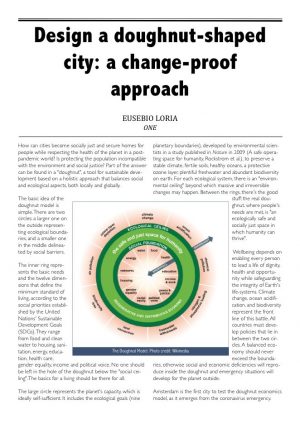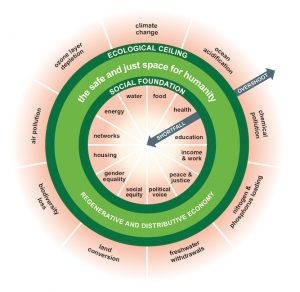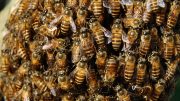 How can cities become socially just and secure homes for people while respecting the health of the planet in a post-pandemic world? Is protecting the population incompatible with the environment and social justice? Part of the answer can be found in a “doughnut”, a tool for sustainable development based on a holistic approach that balances social and ecological aspects, both locally and globally.
How can cities become socially just and secure homes for people while respecting the health of the planet in a post-pandemic world? Is protecting the population incompatible with the environment and social justice? Part of the answer can be found in a “doughnut”, a tool for sustainable development based on a holistic approach that balances social and ecological aspects, both locally and globally.
The basic idea of the doughnut model is simple. There are two circles: a larger one on the outside representing ecological boundaries, and a smaller one in the middle delineated by social barriers.
The inner ring represents the basic needs and the twelve dimensions that define the minimum standard of living, according to the social priorities established by the United Nations’ Sustainable Development Goals (SDGs). They range from food and clean water to housing, sanitation, energy, education, health care, gender equality, income and political voice. No one should be left in the hole of the doughnut below the “social ceiling”. The basics for a living should be there for all.
The large circle represents the planet’s capacity, which is ideally self-sufficient. It includes the ecological goals (nine planetary boundaries), developed by environmental scientists in a study published in Nature in 2009 (A safe operating space for humanity, Rockstrom et al.), to preserve a stable climate, fertile soils, healthy oceans, a protective ozone layer, plentiful freshwater and abundant biodiversity on earth. For each ecological system, there is an “environmental ceiling” beyond which massive and irreversible changes may happen. Between the rings, there’s the good stuff: the real doughnut, where people’s needs are met, is “an ecologically safe and socially just space in which humanity can thrive”.

The classic image of the Doughnut. Photo credit: DoughnutEconomics
Wellbeing depends on enabling every person to lead a life of dignity, health and opportunity while safeguarding the integrity of Earth’s life-systems. Climate change, ocean acidification, and biodiversity represent the front line of this battle. All countries must develop policies that lie in between the two circles. A balanced economy should never exceed the boundaries, otherwise social and economic deficiencies will reproduce inside the doughnut and emergency situations will develop for the planet outside.
Amsterdam is the first city to test the doughnut economics model, as it emerges from the coronavirus emergency. While striving to keep citizens safe, the Dutch municipality with the help of Kate Raworth, a senior researcher at Oxfam and also the creator of the doughnut model, planned the city’s restart in a post-Covid-19 world.
The capital of the Netherlands has the chance to inspire towns, villages, and neighbourhoods to take such a holistic approach, as they begin to re-imagine and re-shape their own futures. It’s a balancing act and, just like for climate change, there is no single, targeted solution that provides self-sufficient, safe, comfortable and healthy living spaces. The problem cities have to face is much larger and systemic than COVID in the air. It is not only an environmental but also an urban planning problem and includes social and economic indicators of city life.
On April 8th, 2020, there was the launch of the Amsterdam City Doughnut initiative, which downscales the global concept of the doughnut to city size and turns it into a tool for transformative action. Amsterdam deputy mayor, Marieke van Doorninck, told The Guardian newspaper that this approach could help the city overcome the impact of the coronavirus crisis: ” It might look strange that we are talking about the period after that but as a government we have to…” she said. “It is to help us to not fall back on easy mechanisms.”
The Dutch capital is a great place for launching the project because it has already placed the doughnut at the heart of its long-term vision and policymaking (see Building blocks for the new strategy-Amsterdam Circular 2020-2025). It also hosts the Amsterdam Donut Coalition, a network of inspiring change-makers who are already putting the doughnut into practice in their city.
But what’s going on in the rest of the world? Nations, cities, neighbourhoods and households are living through a historically unprecedented time, collapsing under Covid-19 pressure and facing non-linear and irreversible consequences. COVID-19 placed many things on hold, giving breath to the climate, but also exacerbated existing problems. The fight against climate change seems to be overshadowed by the pandemic and global economic crisis.
On the other hand, Covid was not only a health emergency, but also a social, political and humanitarian crisis, and cities have immense potential to re-shape humanity and to drive the necessary response in balance with the planet. There’s an urgent need to oppose thepotential longer-term effects of the lockdown on the global economy and to accelerate deadlines for a real Sustainable Development of countries and cities.
“We simply cannot return to where we were before Covid-19 struck, with societies unnecessarily vulnerable to crisis. We need to build a better world” said António Guterres, United Nation Secretary-General. The Doughnut model is a happy but also uncompromising approach to meet this challenge. It sets a vision for an equitable and sustainable future.
In the 20th century, the economy followed the goal of growth, leading to social inequality and ecological collapse. On the one hand, economic growth led to poverty reduction, better health, technological innovation, and (local) environmental improvement. On the other hand, it pushed the environment into the “red-alert zones”.
The doughnut model doesn’t allow economic growth and prosperity to be a goal in itself. The aim is to thrive rather than to grow, and to improve humanity’s quality of life while preventing the ecological limits from being overcome.
After Covid-19, we need a social perspective that shapes – by design – inclusive, equitable, sustainable and healthy economies. Only then humanity will be brought into the doughnut.
Raworth insists there has never been a better time to adopt the doughnut. “The world is experiencing a series of shocks and surprise impacts which are enabling us to shift away from the idea of growth to ‘thriving’. Thriving means our wellbeing lies in [the] balance. We know it so well in the level of our body. This is the moment we are going to connect bodily health to planetary health”. Once the health crisis is over, we cannot let business-as-usual practices lead the way once again.
Eusebio Loria



